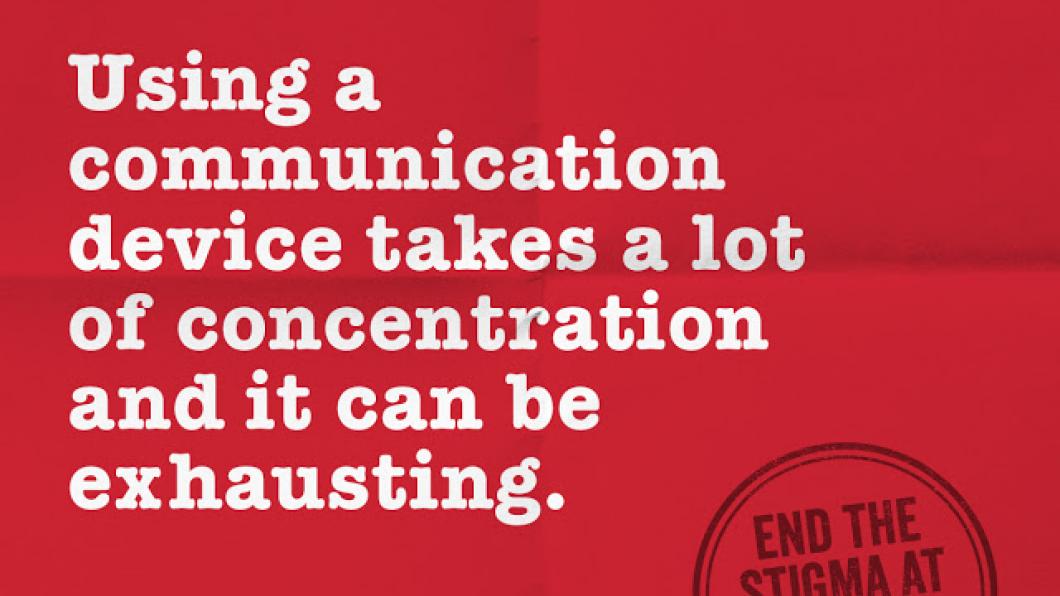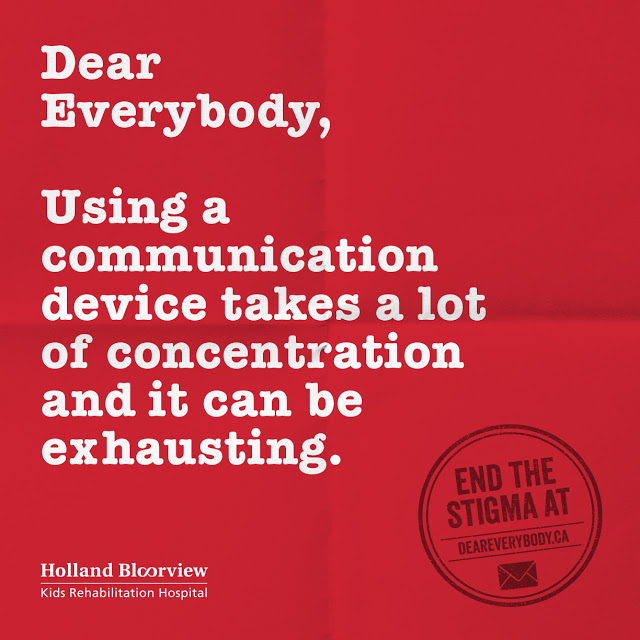
It's 2017, and speech technology is still primitive
By Louise Kinross
I like our Dear Everybody campaign because the messages, like this one above, are real, and come from our children and families.
Most people assumes technology is an equalizer for people with disabilities, and in some cases it is.
But in the 20 years I’ve followed the use of voice devices, and more recently, voice apps that can be used on iPads, I’ve never seen a product that’s nimble, intuitive and fast.
In fact, you may have heard our Dear Everybody radio ad with Gavi, who uses a communication device. What you may not know is that Gavi had to pre-program her comments. She couldn’t express them live, because it isn’t possible to use a device at the speed people speak.
Indeed, “the process is often extraordinarily arduous and fatiguing for the person using the device,” writes McGill University scientist Gail Teachman in a study in Qualitative Inquiry this month.
Last week I had Marna-Rose Minett in my office. She’s raising her seven-year-old granddaughter Rayne, who has cerebral palsy. Marna-Rose noted that Rayne uses her communication device at school, but “we don’t use it much at home because we can understand her speech, and she has to go through so many different screens” to put words together on her device.
“It's slow,” Marna-Rose said. “If she wants something to eat, first she presses ‘I’ and ‘want’ on the first screen, then she picks the icon for ‘food,’ then within food she has to choose between ‘breakfast,’ ‘lunch,’ ‘dinner’ or ‘snack,’ then she chooses what she wants.’”
I likened this cumbersome process to a person needing to look a word up in the dictionary every time they wanted to express it. “Can you imagine if you wanted to say a word, having to flip through a dictionary and find it first?” I said. “And then, when you're finished with that word, you have to look up the next one?”
We both laughed wildly. But it wasn't “ha ha” funny, it was sad and despairing.
There is an app on the market—Speak for Yourself—which tries to keep the number of clicks needed to find a word to two. That’s an improvement.
But anyone who uses mainstream business or consumer technology would gasp in horror if asked to play around with the setup, capabilities and speed of these speech apps and devices.
That’s why a high number of children and youth abandon them.
Recently, I was struck by how many people are instead using using a letterboard and spelling out words, letter by letter, which are then spoken by a partner, to communicate.
That’s how Japanese author Naoki Higashida, who has autism and is largely non-verbal, wrote his two books: The Reason I Jump and Fall Down 7 Times, Get Up 8.
In ABC’s hit Speechless, actor Micah Fowler communicates by selecting letters to form words with a laser pointer attached to his glasses.
One of our clients spoke to me the other day by pointing to letters to form words on his letterboard, while I spoke the words to confirm accuracy.
Over the years, I’ve seen scientists study why children and youth abandon voice devices. And I’ve always thought: “Why wouldn’t they?”
“I keep hoping that Apple will develop a voice app or device that is as intuitive and user-friendly as its other products,” I wrote in a blog in 2014. “However, I’ve been hoping that for more than 15 years. I even began a small campaign of tweets to Apple CEO Tim Cook last year that went unanswered. I think the big computer makers have let our families down in not bringing their expertise to the AAC table.”
Why is it okay, in 2017, that people with limited speech have to endure an “extraordinarily arduous and fatiguing process” as their only option for self-expression?
If current technology was sophisticated and speedy, why would a famous author choose to write his books by pointing to letters on a letterboard?
Why would my son prefer to use sign language, even though it drastically restricts who he can communicate with?
I have an idea for a scientist. I want a researcher to use a voice device for one week—24hours a day—and not use the keyboard, because many young kids using devices can’t spell. Then, write a paper about how “easy” or “hard” it is to use, and how it compares to an Apple device.
I e-mailed my idea to scientist Gail Teachman, and this is how she responded: “I think a really important aspect of that researcher’s learning would be that NOT ONLY are devices slow, hard to use and clunky, but using an AAC device can be stigmatizing. The researcher would very likely experience social interactions where suddenly they are not seen as an expert, not smart…”
There would be “lots of being spoken to ‘like a child’ and an absence of the respect they are used to receiving from listeners. In short, what they have to say would suddenly be judged less valuable, less worthy of another person’s attention, less important and therefore, not worth the time it takes to listen.”
Why is that experience acceptable for children who struggle to speak?
Years ago, I spoke to the head of our research department about applying for one of Bill Gates’ Grand Challenges grants to develop an intuitive voice device. But the grant needed to create a life-changing solution for large markets of people around the world
The number of people using voice technology is relatively small. But it still makes zero sense to me why Apple or Microsoft wouldn’t choose to enter the market for the goodwill they would generate alone. The media stories generated would be solid gold.
Gail Teachman is a postdoctoral fellow at McGill University with the Views on Interdisciplinary Childhood Ethics team. Her research examines the moral experiences of children—their views on what it right and wrong, good and bad, and just and unjust—particularly in the context of childhood disability.
